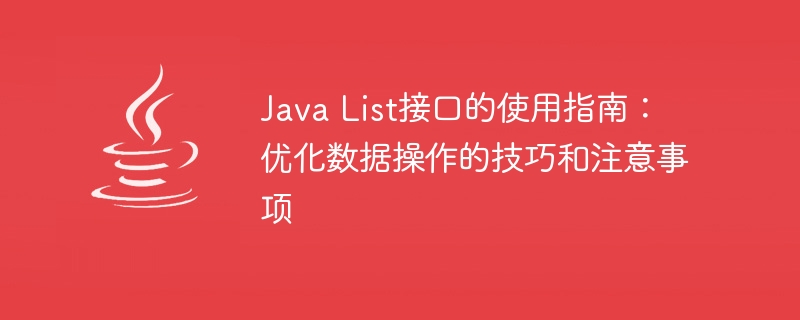
The Java List interface is one of the commonly used data structures in the Java collection framework. It provides an ordered and dynamic data storage method. The implementation classes of the List interface include ArrayList, LinkedList, etc. They have their own advantages and applicability in different scenarios. This article will focus on the usage guide of the Java List interface, including tips and precautions for optimizing data operations.
1. Introduction to Java List interface
In Java, the List interface inherits from the Collection interface, which defines a series of methods for operating collection elements. The elements in the List collection are ordered and can contain repeated elements. Commonly used List interface implementation classes include ArrayList and LinkedList. ArrayList is implemented based on arrays and is suitable for random access and storage of a large number of elements; LinkedList is implemented based on linked lists and is suitable for frequent insertion and deletion operations.
2. Tips for optimizing data operations
- Use appropriate data structures
When choosing to use ArrayList and LinkedList, you should decide based on specific scenarios and needs. For frequent insertion and deletion operations, LinkedList should be selected; for storage and random access of a large number of elements, ArrayList should be selected.
- Avoid frequent expansion
When adding elements to ArrayList, if the capacity is insufficient, the expansion operation will be triggered, which will lead to memory reallocation and data copying. In order to avoid frequent expansion, you can reserve space in advance by setting the initial capacity to avoid unnecessary performance overhead.
- Use Iterator to traverse the collection
When traversing the List collection, it is recommended to use the Iterator interface instead of the ordinary for loop. Iterator provides a safe traversal method and supports addition and deletion of elements during the traversal process.
- Reasonable use of the subList method
The List interface provides the subList method to obtain a sublist, but it should be noted that subList returns a view of the original list, and modifications to the sublist will affect the original list. In order to prevent ConcurrentModificationException exceptions, you should try to avoid modifying the original list while traversing.
- Use the Collections class for sorting and searching
Java provides the Collections class to sort and search the List collection, such as using the Collections.sort method to sort the list, and using the Collections.binarySearch method to perform binary search . These methods can handle large data collections efficiently.
3. Notes
- Thread safety
The implementation classes ArrayList and LinkedList of the List interface are not thread-safe. If you need to operate in a multi-threaded environment , you need to consider using thread-safe collection classes, or perform appropriate synchronization when using them.
- Attention to null pointer exception
When operating on the List collection, you need to pay attention to the null pointer exception. Especially for ArrayList, when the element is null, it may cause a null pointer exception.
- Think about performance and memory consumption
When using the List interface, you need to weigh performance and memory consumption. For example, ArrayList has better performance in random access, but insertion and deletion operations will involve copying and moving the array, while LinkedList has better performance in insertion and deletion operations, but is less efficient in random access.
In short, the Java List interface is a very commonly used data structure in the Java collection framework. Mastering its usage skills and precautions is crucial to optimizing data operations and improving program performance. Properly selecting the implementation class of the List interface and using appropriate data structures and methods can effectively improve the efficiency and maintainability of the program. I hope this article can bring some help to readers so that they can become more proficient in using the Java List interface for data operations.
The above is the detailed content of Tips and precautions for operating Java List: Improve the efficiency of data operations. For more information, please follow other related articles on the PHP Chinese website!






